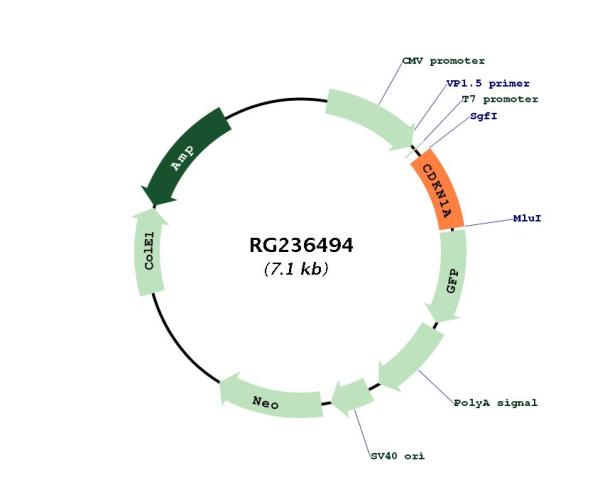p21 (CDKN1A) (NM_001291549) Human Tagged ORF Clone
CAT#: RG236494
- TrueORF®
CDKN1A (tGFP-tagged) - Human cyclin-dependent kinase inhibitor 1A (p21, Cip1) (CDKN1A), transcript variant 3
ORF Plasmid: DDK
"NM_001291549" in other vectors (2)
Specifications
| Product Data | |
| Tag | TurboGFP |
| Symbol | p21 |
| Synonyms | CAP20; CDKN1; CIP1; MDA-6; P21; p21CIP1; SDI1; WAF1 |
| Vector | pCMV6-AC-GFP |
| E. coli Selection | Ampicillin (100 ug/mL) |
| Mammalian Cell Selection | Neomycin |
| Sequence Data |
>RG236494 representing NM_001291549.
Blue=ORF Red=Cloning site Green=Tag(s) GCTCGTTTAGTGAACCGTCAGAATTTTGTAATACGACTCACTATAGGGCGGCCGGGAATTCGTCGACTG GATCCGGTACCGAGGAGATCTGCCGCCGCGATCGCC ATGTGGGGAGTATTCAGGAGACAGACAACTCACTCGTCAAATCCTCCCCTTCCTGGCCAACAAAGCTGC TGCAACCACAGGGATTTCTTCTGTTCAGGCGCCATGTCAGAACCGGCTGGGGATGTCCGTCAGAACCCA TGCGGCAGCAAGGCCTGCCGCCGCCTCTTCGGCCCAGTGGACAGCGAGCAGCTGAGCCGCGACTGTGAT GCGCTAATGGCGGGCTGCATCCAGGAGGCCCGTGAGCGATGGAACTTCGACTTTGTCACCGAGACACCA CTGGAGGGTGACTTCGCCTGGGAGCGTGTGCGGGGCCTTGGCCTGCCCAAGCTCTACCTTCCCACGGGG CCCCGGCGAGGCCGGGATGAGTTGGGAGGAGGCAGGCGGCCTGGCACCTCACCTGCTCTGCTGCAGGGG ACAGCAGAGGAAGACCATGTGGACCTGTCACTGTCTTGTACCCTTGTGCCTCGCTCAGGGGAGCAGGCT GAAGGGTCCCCAGGTGGACCTGGAGACTCTCAGGGTCGAAAACGGCGGCAGACCAGCATGACAGATTTC TACCACTCCAAACGCCGGCTGATCTTCTCCAAGAGGAAGCCC ACGCGTACGCGGCCGCTCGAG - GFP Tag - GTTTAAAC >Peptide sequence encoded by RG236494
Blue=ORF Red=Cloning site Green=Tag(s) MWGVFRRQTTHSSNPPLPGQQSCCNHRDFFCSGAMSEPAGDVRQNPCGSKACRRLFGPVDSEQLSRDCD ALMAGCIQEARERWNFDFVTETPLEGDFAWERVRGLGLPKLYLPTGPRRGRDELGGGRRPGTSPALLQG TAEEDHVDLSLSCTLVPRSGEQAEGSPGGPGDSQGRKRRQTSMTDFYHSKRRLIFSKRKP TRTRPLEMESDESGLPAMEIECRITGTLNGVEFELVGGGEGTPEQGRMTNKMKSTKGALTFSPYLLSHV MGYGFYHFGTYPSGYENPFLHAINNGGYTNTRIEKYEDGGVLHVSFSYRYEAGRVIGDFKVMGTGFPED SVIFTDKIIRSNATVEHLHPMGDNDLDGSFTRTFSLRDGGYYSSVVDSHMHFKSAIHPSILQNGGPMFA FRRVEEDHSNTELGIVEYQHAFKTPDADAGEERV |
| Restriction Sites |
SgfI-MluI
Cloning Scheme for this gene
Plasmid Map

|
| ACCN | NM_001291549 |
| ORF Size | 594 bp |
| OTI Disclaimer | The molecular sequence of this clone aligns with the gene accession number as a point of reference only. However, individual transcript sequences of the same gene can differ through naturally occurring variations (e.g. polymorphisms), each with its own valid existence. This clone is substantially in agreement with the reference, but a complete review of all prevailing variants is recommended prior to use. More info |
| OTI Annotation | This clone was engineered to express the complete ORF with an expression tag. Expression varies depending on the nature of the gene. |
| Product Components | The ORF clone is ion-exchange column purified and shipped in a 2D barcoded Matrix tube containing 10ug of transfection-ready, dried plasmid DNA (reconstitute with 100 ul of water). |
| Reference Data | |
| RefSeq | NM_001291549.3 |
| RefSeq Size | 2325 bp |
| RefSeq ORF | 597 bp |
| Locus ID | 1026 |
| UniProt ID | P38936 |
| Cytogenetics | 6p21.2 |
| Protein Families | Druggable Genome |
| Protein Pathways | Bladder cancer, Cell cycle, Chronic myeloid leukemia, ErbB signaling pathway, Glioma, Melanoma, p53 signaling pathway, Pathways in cancer, Prostate cancer |
| MW | 22.4 kDa |
| Gene Summary | This gene encodes a potent cyclin-dependent kinase inhibitor. The encoded protein binds to and inhibits the activity of cyclin-cyclin-dependent kinase2 or -cyclin-dependent kinase4 complexes, and thus functions as a regulator of cell cycle progression at G1. The expression of this gene is tightly controlled by the tumor suppressor protein p53, through which this protein mediates the p53-dependent cell cycle G1 phase arrest in response to a variety of stress stimuli. This protein can interact with proliferating cell nuclear antigen, a DNA polymerase accessory factor, and plays a regulatory role in S phase DNA replication and DNA damage repair. This protein was reported to be specifically cleaved by CASP3-like caspases, which thus leads to a dramatic activation of cyclin-dependent kinase2, and may be instrumental in the execution of apoptosis following caspase activation. Mice that lack this gene have the ability to regenerate damaged or missing tissue. Multiple alternatively spliced variants have been found for this gene. [provided by RefSeq, Sep 2015] |
Documents
| Product Manuals |
| FAQs |
| SDS |
Resources
{0} Product Review(s)
Be the first one to submit a review






























































































































































































































































 Germany
Germany
 Japan
Japan
 United Kingdom
United Kingdom
 China
China

